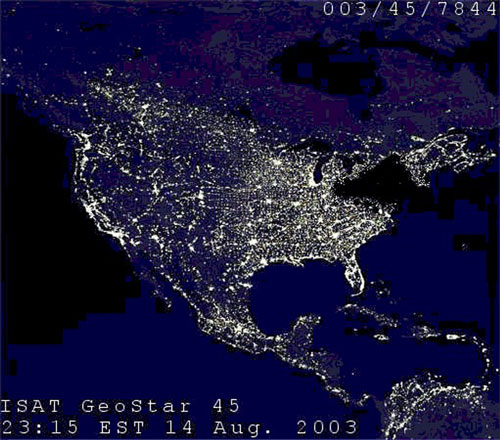
Alaska Science The chaos behind the wall socket
July 22, 2011
David Newman studies the workings of complex, chaotic systems as part of his research at the University of Alaska Fairbanks. He and three colleagues once wrote a paper about “cascading” power blackouts similar to the largest in the history of the world, which affected 50 million people on August 14, 2003.
A satellite image of the northeastern U.S. taken by the Defense Meteorological Satellite Program on Aug. 14, 2003 at 9:03 p.m., when a blackout affected 50 million people.
From his office on the UAF campus, Newman described the vulnerability of the large systems that bring power to homes in much of North America. “Events like (the blackout of 2003) happen for two reasons: we sit on the teetering edge of collapse with our power demands, plus we’re interconnected,” he said. Most cities do not have power generators large enough to provide enough electricity during times of peak demand, such as a hot summer day in New York City. “If we had to supply each city on its neighboring power plants in times of peak need, forget it,” Newman said. To satisfy the call for power at peak times, electrical utilities buy power from other plants. Though Alaska’s electrical power systems are separate from the Lower 48, a few large regions of the U.S. are connected. The intertwined nature of the system makes it possible to share electricity, but the connected lines also make the system prone to avalanching power outages, such as the blackout that cut the electricity of 50 million Americans and Canadians in nine seconds. In a possible scenario for the blackout of 2003 reported by the Cleveland Plain Dealer, a 600-megawatt coal-fed generator in Eastlake, Ohio shut down, tripping a transmission line, then a second line sagged into a tree in a nearby town and shorted out. The damage to the second line shunted too much power to other lines in Ohio, many of which shut down. With so many customers then without electricity, power from generators working at full capacity surged through lines in central Michigan, causing protective relays to trip and shutting off power there. In seconds, the same scenario played out at power plants and transmission stations from Michigan to Toronto to New York, cutting electricity to a large portion of the U.S. but preventing serious damage to power plants and transmission lines. One problem with the electrical system of North America is a 2 percent increase of U.S. power demand each year and a lack of simultaneous upgrades to power generators and transmission lines, Newman said. “Couple this to some hot summer days and we have a system sitting on the edge waiting for something to push it over,” Newman wrote in an editorial he submitted to the Washington Post. What’s the solution for the way we generate, transmit, and share our electricity? Newman said that while it will be possible to prevent the specific problems that caused the 2003 blackout, other, unpredictable problems as small as a squirrel chewing through insulation at a power-transmission substation will continue to threaten the system. In the short run, people can manage the power problem by installing more power wires to spread out the load and by increasing the capacity of power plants. In the long run, as Newman wrote in another paper “major disruptions from a wide variety of sources are a virtual certainty in a complex system.”
This column is provided as a public service by the Geophysical Institute, University of Alaska Fairbanks, in cooperation with the UAF research
E-mail your news &
photos to editor@sitnews.us
|
||
